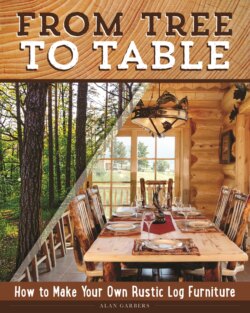Читать книгу From Tree to Table - Alan Garbers - Страница 9
На сайте Литреса книга снята с продажи.
ОглавлениеCHAPTER 1 GETTING IDEAS AND FINDING INSPIRATION
For me, getting ideas was never difficult; implementing them has always been the hard part. If you are short on ideas, travel to a state or national park that has a lodge or inn. Almost without exception, they will have log furniture placed in the lobby or other common areas.
Lodges, hotels, and shops are a fantastic place to get ideas for rustic and log furniture. It’s a great way to see how other craftsman made their artwork.
I strongly recommend stopping at every rustic and log furniture store you see. Gatlinburg, Tennessee, is almost overrun with log furniture outlets and makers, as are other tourist destinations. Go into any Bass Pro Shop or Cabela’s and you’ll see countless pieces of log furniture. Take pictures if they allow it. You can’t help going away with hundreds of ideas on how to replicate or improve on the furniture you saw.
In some cases, you might think that a piece is too complex to make. It might be, right now. But, as you gain experience (and accrue tools), things that were impossible become possible. In some cases, you might walk away emboldened, thinking, “Heck, I can do better than that!” And you’re right, you probably can.
If you still need inspiration, find a copy of Rustic Artistry for the Home by Ralph Kylloe. The book is filled cover-to-cover with photos of beautiful log and rustic creations.
Visit living history museums like Cades Cove in Tennessee or Conner Prairie in Indiana. Pioneers made many of their necessities from what was available in the woods and all they had invested was time. The Foxfire series of books documents much of the commonplace knowledge that is fading from society. Among the many topics in the series is making rustic furniture the Appalachian way and even building a lumber kiln.
Why Not Buy Log Furniture?
I know why I don’t buy every piece of log furniture I fall in love with: I’m not made of money. And, as a woodworker, I always think I can make something like it or better. But, we have bought some items, mainly because there’s no way I could build the piece for the price they were asking, nor did I have the time or tools to make it. Let’s face it, most of us don’t have unlimited space for the ultimate workshop, nor do we have tons of spare time. In some cases, I have to face reality, go against every fiber of my being, and let somebody else do the work for me.
Think Like an Artist but Build Like a Machinist
Log and twigs lend themselves well to whimsical creations. Let your mind flow with the possibilities and reach for the stars. But while doing that, realize things have to hold together and work as desired.
Machinists are very precise. They don’t machine anything without a blueprint on how to make it. Every cut and dimension is drawn out long before the mill or lathe is started. A table has to be level. A chair has to sit properly. A coat rack can’t fall over when a heavy coat is hung upon it. So, while being creative, also plan it out like a machinist, and make sure it’s going to work right before you make the first cut. Start by making a simple drawing of what you want to make. Figure out how tall, wide, and long the piece needs to be to fill the need.
When I say build like a machinist, what I’m saying is to plan the work before cutting, then work the plan while building.
As you read this book, you’ll find I repeat myself at times. That’s because I know most of you are like me and don’t start reading a how-to book at the beginning. We flip through the pages until we find the topic we want to read. So, if I felt one topic was important to know while covering another topic, I went over it again so you won’t miss something.
You’re welcome.
